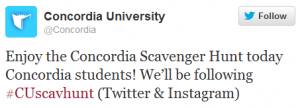We maintain a regular focus on social media because it is an integral part of your school’s visibility and accessibility. But in order to have social media help you achieve certain marketing and communication goals, it must be used effectively. Similar to how a physically present but inattentive student will likely fare poorly in a class, simply being on social media is not enough for it to work to your school’s advantage. Your school can have dozens of live social media accounts, but if you are not using them effectively or if you are not regularly active on those platforms, then you will not achieve the desired result. When it comes to social media, both quality and quantity count viz. posts need to be meaningful relevant, and your presence must be frequent and consistent.
Case in point: The Twitter hashtag.

Granted, the logistics of hashtags are fairly straight forward: Use the # sign before a word or term in order to tag your tweet, thereby making it easier for others to search for the hashtag or to join the conversation by using the given hashtag in their own tweets.
For example, let’s say your school is XYZ University. Your school is planning an open house. As a way to distinguish any open house-related tweets from others, you would simply tag it with #XYZopenhouse (or whichever term you feel is appropriate).
Easy enough, right? Well, it can be, but it can also be quite easy to have hashtags work against you. Here are three quick wins that will help you master the art of hashtagging.
1) Be Distinct
Schools tend to invest time and resources in the same types of projects and initiatives (i.e. research, student recruitment, international profile, community engagement, etc.), and it is likely that schools will also want to promote these projects on social media platforms. That said, what becomes tricky is not so much launching the hashtag campaign as it is in thinking of a hashtag that will preserve your school’s distinctiveness.
For example, there are obvious risks in using generic hashtags like #academicplan or #studyabroad. Too many schools run these types of initiatives, making it likely that they too will (or already have) claim the same hashtag as their own. What you want to do is opt for a hashtag that is still relevant but distinct enough to stand alone. This can be as easy as putting your school’s initials in the hashtag. Suitable hashtags for your school’s academic plan and international programs could be #XYZplan2012 and #XYZintl, respectively. Ultimately, think of customized hashtags as a way to brand your tweets .
Here’s how Concordia University in Montreal customized their hashtags in order to promote a back-to-school activity:
2) Maximize Your Reach
There is no limit the number of hashtags you put in a single tweet. This does not mean that all 140 characters should be used up by hashtags, but it does mean that you can use more than one hashtag as a way to expand your tweet’s reach.
If we think of how many schools exist around the world, and the number of students, faculty and staff that fill them, it’s safe to assume that many people have used the same hashtags to plug their school’s campaigns or initiatives. Similar to generic hashtags, duplicate hashtags can cause your tweets to get lost in the cybersphere. But if you use both generic and distinct hashtags in a single tweet, then you are effectively joining a broad conversation (i.e. #research) and highlighting your school’s own initiative (i.e. #XYZsciencepilot).
Here’s how University of Toronto combines both generic and unique hashtags in a single post:
This tweet’s use of duplicate/generic hashtags (#doctors, #students, and #research) allows it to be a part of ongoing general conversations across various demographics. Interestingly enough, #boundlessimpact is a unique hashtag used exclusively by U of T. Notice how #boundlessimpact is not branded, yet still achieves the goal of avoiding duplicates.
3) Interact
There is nothing worse in the social media world than idle users. The point of social media is to actually be social, which entails taking the time to interact, converse, explore and discover other people’s thoughts.
If you launch a hashtag campaign, make sure that your school is actually involved in the conversation. This involves looking up and interacting with other users that are using the hashtag, as well as actually using the hashtag multiple times in relevant tweets. Ideally, your school’s hashtags will catch on within your school’s physical and social media community, and a great way to help this happen to give your hashtag steady momentum.
Here’s an example of how Dalhousie University’s interacts with students regarding their school pride hashtag campaign:
How does your school distinguish their hashtag campaigns?








